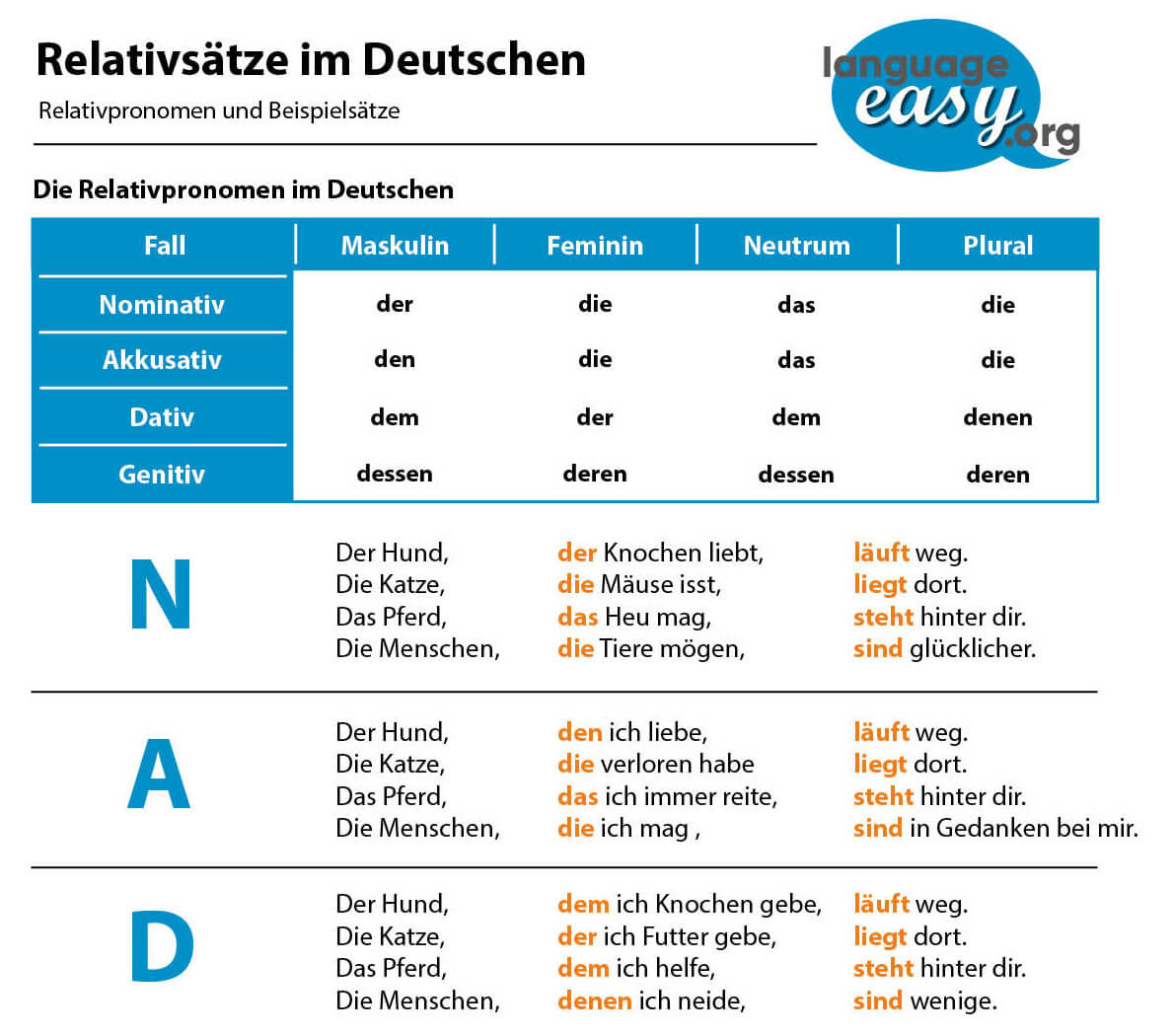German Relative Clauses
Relativsätze im Deutschen – Erklärungen und Beispiele
German Relative Clauses – Summary
Zusammenfassung
Relative clauses are subordinate clauses which are used as an attribute for a noun. They are always come with relative pronouns. Relative pronouns are, for example, “”der, die, das, welcher, welche, welches” …
At the end of a relative clause there’s always a conjugated verb. This type of subordinate clause is also the most frequent one in the German language. The relative pronouns can occur in different forms:
- In nominative: “Der Hund, der da sitzt, bellt mich an.”
- In genitive: “Der Hund, dessen Knochen riesig ist, wedelt mit dem Schwanz.”
- In dative: “Der Hund, dem ich einen Knochen gab, ist sehr glücklich.”
- In accusative: “Die Pferde, die ich sah, gefielen mir sehr gut.”
- With preposition: “Man hat das Haus, in dem wir wohnten, jetzt verkauft.”
Well, have you also asked yourself why everyone considers German grammar to be such difficult? As in every other language, you just need a good dictionary and you are ready to at least write texts in German.
Unfortunately, the German language is not that easy. Once you have reached a certain level, you will need subordinate clauses to express more information in one sentence. And what’s in between? Exactly, conjunctions and pronouns. So, in this article on language-easy.org I’d like to talk about a specific type of German subordinate clause, the German relative clauses.
In the following, I’d like to talk about the different types of German relative clauses and also give a short description of this subordinate clause. Also, the construction of these sentence and their word order will be a topic. Finally, I’d like to mention German relative pronouns and relative adverbs.
Description of German Relative Clauses
Eine Beschreibung von Relativsätzen im Deutschen
First of all we will describe what a German relative clause actually is.
So, German relative clauses can add additional information about a noun without beginning a new clause. Furthermore, they can be used to combine two main clauses. It is also important to know that German relative clauses are always introduced by relative pronouns: “der, die, das” for people and things. German relative clauses are always set off by commas.
Well, as we have seen in the description, German relative clauses can give additional information about subject or object and, additionally, convert to main clauses into a complex clause. So, that’s why a German relative clause can be in the nominative, accusative, dative and genitive case. In the following, I’d like to give you some examples that illustrate what I mean.
Examples for German Relative Clause in different Cases
First of all, let’s start with the nominative case:
- “Philip, der einen Hund hat, geht mit ihm Gassi.”
Second, the relative clause in the accusative case:
- “Philip, den ich seit der Grundschule kenne, ist mein bester Freund.”
Third, this type of subordinate clause in the dative case:
- “Philip, dem ich einen Hund geschenkt habe, liebt ihn sehr.”
And finally the genitive case:
- “Philip, dessen Hund noch sehr jung ist, kümmert sich gut um ihn.”
The Construction and Word Order of German Relative Clauses
Die Konstruktion und der Satzbau von Relativsätzen im Deutschen
Well, let’s come to the next point of this article about German relative clause, their construction and word order. So, you have to consider that you need two elements to introduce this German subordinate clause:
- Relative pronouns
- Relative adverbs
Later on we will talk about each of these conjunctions. So, normally, these elements come directly after the subject or the object to which they refer. Of course, this can be in the middle of the sentence or at its end. Please, keep in mind the verb in a German relative clause is always put at the end of the sentence.
Now, let’s have a short look at this table. Here, you will see the German relative pronouns “der” and “welcher“. Of course, they are shown in different cases, number and gender.
German Relative Pronouns

Logically, the case in which you have to put the German relative pronoun depends on whether it replaces a subject or an object. Please, keep in mind that clauses in relative clauses differ from those in the main clause. So, here are some examples:
- “Philip, den ich sehr gerne mag, hat einen Hund.” – Philip, who I like very much, has a dog.
(Wer? Philip hat einen Hund.)
(Wen? Philip mag ich sehr gerne.)
By the way, you should keep in mind that mainly the relative pronouns “der, die, das” are used in German, whereas “welcher, welche, welches” are not so common. Nevertheless, they are used to avoid the repetition of words.
- “Das ist die Frau, die die Kuchen verkauft.” – That’s the woman who sells pies.
- “Das ist die Frau, welche die Kuchen verkauft.” – That’s the woman who sells pies.
Finally, we will come to the last point of this article, the German relative adverbs.
German Relative Adverbs
Well, this point is not too complicated. Just keep in mind that relative adverbs do not change their form. So, they often refer to an entire clause rather than a single noun. Some relative adverbs are, for example, “was, wo, womit, wofür, worüber“.
- “Philip hat einen Hund, was mir sehr gefällt.” – Philip has a dog, which I like very much.
- “Philip wartet dort, wo der Bus steht.” – Philip waits there, where the bus is.
- “Peter weiß nicht, wofür er hier ist.” – Peter doesn’t know for what he is here.
- “Ich weiß nicht, worüber der Film handelt.” – I don’t know what this movie is about.
Exercises
Übungen



